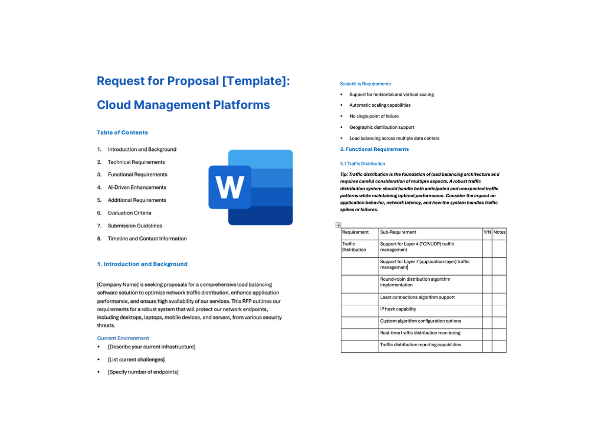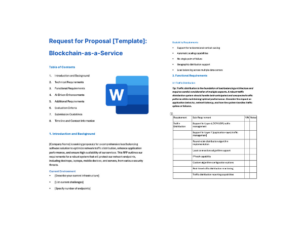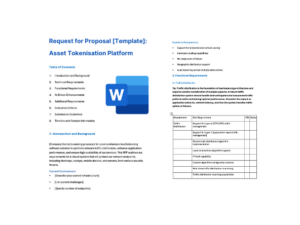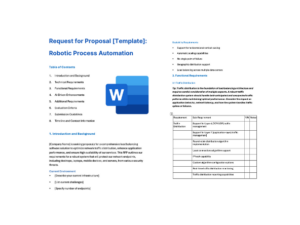Request for Proposal: Cloud Management Platform Solution
Table of Contents
- Introduction
- Technical Requirements
- Functional Requirements
- AI-Driven Enhancements
- Vendor Requirements
- Evaluation Criteria
- Submission Guidelines
- Timeline
1. Introduction
[Organization Name] is seeking proposals for a comprehensive Cloud Management Platform (CMP) to optimize our multi-cloud and hybrid cloud environments. This RFP outlines our requirements for a robust system that will enable efficient management, monitoring, and optimization of our cloud infrastructure.
Organization Background
- Brief description of your organization
- Industry and specific regulatory requirements
- Current cloud infrastructure overview
- Scale of operations
Current Environment
- Description of current cloud management practices
- Existing tools and systems
- Pain points and challenges
Project Goals
- Primary objectives for implementing a CMP
- Specific challenges to address
- Expected outcomes
2. Technical Requirements
2.1 Multi-Cloud Compatibility
- Support major cloud providers (AWS, Azure, Google Cloud Platform, etc.)
- Ensure compatibility with private cloud infrastructures
- Enable hybrid cloud management
- Support cross-cloud orchestration
- Provide unified management interface
2.2 API Integration
- Provide extensive API support for integration with existing IT systems and tools
- Enable custom integrations and workflows
- Support RESTful APIs with comprehensive documentation
- Offer SDK or plugin architecture
- Support secure API authentication and access control
2.3 Scalability
- Demonstrate ability to scale with growing cloud infrastructure and data volumes
- Support enterprise-scale deployments
- Enable horizontal and vertical scaling
- Handle increasing workloads efficiently
- Provide performance optimization capabilities
2.4 Performance
- Maintain low latency in monitoring and management operations
- Handle high volumes of data and concurrent users efficiently
- Support real-time operations and updates
- Optimize resource utilization
- Provide performance monitoring and reporting
2.5 Data Security and Privacy
- Implement robust data encryption (at rest and in transit)
- Offer granular access controls and role-based permissions
- Support data sovereignty requirements
- Ensure secure communication protocols
- Provide audit trails and compliance reporting
2.6 Backup and Disaster Recovery
- Provide built-in or integrated backup capabilities
- Support disaster recovery planning and execution
- Enable data replication
- Automated backup verification
- Support recovery point and time objectives
2.7 Reporting and Analytics
- Offer customizable reporting tools and dashboards
- Support export of data in various formats
- Advanced analytics capabilities
- Custom report creation
- Real-time reporting features
2.8 Mobile Access
- Provide mobile applications or responsive web interfaces
- Enable on-the-go management
- Secure mobile access
- Cross-platform support
- Mobile-optimized dashboards
2.9 Integration Capabilities
- Support integration with existing IT service management (ITSM) tools
- Compatibility with popular DevOps and CI/CD tools
- Enable third-party tool integration
- Support for standard protocols
- API-driven integration capabilities
2.10 Customization and Extensibility
- Allow for custom script execution
- Support workflow automation
- Provide SDK or plugin architecture
- Enable platform customization
- Support custom development
3. Functional Requirements
3.1 Multi-Cloud Resource Monitoring and Optimization
Tip: This fundamental capability enables unified visibility and control across diverse cloud environments. Effective monitoring and optimization directly impact operational efficiency and cost management, making this a critical foundation for successful cloud operations.
| Requirement |
Sub-Requirement |
Y/N |
Notes |
| Resource Monitoring |
Monitor resources across public clouds |
|
|
|
Monitor resources across private clouds |
|
|
|
Monitor resources across hybrid environments |
|
|
|
Real-time resource tracking |
|
|
| Resource Optimization |
Resource allocation optimization tools |
|
|
|
Usage efficiency tracking |
|
|
|
Performance metrics monitoring |
|
|
|
Cost optimization recommendations |
|
|
| Capacity Management |
Resource utilization tracking |
|
|
|
Performance metrics analysis |
|
|
|
Capacity planning tools |
|
|
|
Usage trend analysis |
|
|
3.2 Self-Service Capabilities
Tip: Self-service functionality empowers users while reducing IT overhead. A well-designed self-service portal balances user autonomy with appropriate controls, streamlining resource provisioning while maintaining governance.
| Requirement |
Sub-Requirement |
Y/N |
Notes |
| Portal Features |
Self-service resource management portal |
|
|
|
Cloud resource provisioning capabilities |
|
|
|
User-friendly interface |
|
|
|
Customizable dashboard |
|
|
| Usage Tracking |
Consumption pattern monitoring |
|
|
|
Resource adjustment tools |
|
|
|
Usage reporting |
|
|
|
Cost allocation tracking |
|
|
| Access Control |
Role-based access management |
|
|
|
User permission configuration |
|
|
|
Access audit trails |
|
|
|
Policy enforcement |
|
|
3.3 Cost Control and Optimization
Tip: Strategic cost management is critical for cloud operations, combining real-time monitoring with automated optimization tools. This ensures efficient resource utilization while maintaining budget control and providing clear visibility into spending patterns across all cloud environments.
| Requirement |
Sub-Requirement |
Y/N |
Notes |
| Resource Cost Tracking |
Cloud resource utilization monitoring |
|
|
|
Cost association with resources |
|
|
|
Real-time cost tracking |
|
|
|
Historical cost analysis |
|
|
| Cost Optimization |
Automated cost-saving measures |
|
|
|
Unused resource identification |
|
|
|
Efficiency recommendations |
|
|
|
Resource hibernation automation |
|
|
| Billing Management |
Detailed billing reports |
|
|
|
Chargeback capabilities |
|
|
|
Cost allocation |
|
|
|
Budget tracking |
|
|
3.4 Compliance Management
Tip: Comprehensive compliance management ensures adherence to regulatory requirements while providing automated monitoring and reporting capabilities. This is essential for maintaining security standards and meeting audit requirements across cloud environments.
| Requirement |
Sub-Requirement |
Y/N |
Notes |
| Regulatory Compliance |
GDPR compliance features |
|
|
|
HIPAA compliance support |
|
|
|
PCI DSS compliance tools |
|
|
|
Industry-specific regulation support |
|
|
| Audit Tools |
Compliance audit automation |
|
|
|
Regular compliance checks |
|
|
|
Audit trail maintenance |
|
|
|
Evidence collection |
|
|
| Reporting |
Compliance reporting tools |
|
|
|
Custom report generation |
|
|
|
Real-time compliance status |
|
|
|
Violation alerts |
|
|
3.5 Logs Monitoring
Tip: Effective log monitoring provides crucial insights into system behavior and security events. This capability combines real-time analysis with historical data to identify issues and maintain operational integrity.
| Requirement |
Sub-Requirement |
Y/N |
Notes |
| Log Collection |
Integration with resource logs |
|
|
|
Centralized log gathering |
|
|
|
Real-time log streaming |
|
|
|
Log format standardization |
|
|
| Analysis Features |
Error detection |
|
|
|
Vulnerability identification |
|
|
|
Compliance issue tracking |
|
|
|
Security threat detection |
|
|
| Management Tools |
Log retention policies |
|
|
|
Log search capabilities |
|
|
|
Log archival features |
|
|
|
Log export options |
|
|
3.6 Security Management
Tip: Comprehensive security management integrates multiple security layers to protect cloud resources and data. This encompasses everything from access control to threat detection, ensuring robust security across the entire cloud infrastructure.
| Requirement |
Sub-Requirement |
Y/N |
Notes |
| Security Features |
Data encryption capabilities |
|
|
|
Access control management |
|
|
|
Real-time threat detection |
|
|
|
Security policy enforcement |
|
|
| Policy Management |
Security policy creation |
|
|
|
Policy distribution |
|
|
|
Policy compliance monitoring |
|
|
|
Policy update automation |
|
|
| Monitoring & Response |
Security event monitoring |
|
|
|
Threat response automation |
|
|
|
Incident tracking |
|
|
|
Security reporting |
|
|
3.7 Policy-Based Automation
Tip: Policy-based automation enables consistent, rule-driven operations across cloud environments. This capability ensures standardized processes while reducing manual intervention and human error.
| Requirement |
Sub-Requirement |
Y/N |
Notes |
| Automation Features |
Routine task automation |
|
|
|
Resource scaling automation |
|
|
|
Load balancing automation |
|
|
|
Event response automation |
|
|
| Policy Management |
Custom policy creation |
|
|
|
Policy enforcement |
|
|
|
Policy distribution |
|
|
|
Policy version control |
|
|
| Implementation |
Automated workflow creation |
|
|
|
Task scheduling |
|
|
|
Event trigger configuration |
|
|
|
Error handling |
|
|
3.8 Workload Optimization
Tip: Workload optimization ensures efficient resource utilization while maintaining performance objectives. This capability provides intelligent resource allocation and performance tuning based on workload demands.
| Requirement |
Sub-Requirement |
Y/N |
Notes |
| Resource Management |
Dynamic resource allocation |
|
|
|
Workload monitoring |
|
|
|
Performance tracking |
|
|
|
Resource utilization analysis |
|
|
| Decision Support |
Policy framework creation |
|
|
|
Resource allocation recommendations |
|
|
|
Performance optimization suggestions |
|
|
|
Cost optimization analysis |
|
|
| Implementation |
Automated resource adjustment |
|
|
|
Performance tuning |
|
|
|
Workload balancing |
|
|
|
Capacity planning |
|
|
3.9 Integration with DevOps Tools
Tip: Seamless DevOps integration enables efficient development and operations workflows. This capability connects with CI/CD pipelines and infrastructure-as-code tools to support modern development practices.
| Requirement |
Sub-Requirement |
Y/N |
Notes |
| CI/CD Integration |
Pipeline integration capabilities |
|
|
|
Build process support |
|
|
|
Deployment automation |
|
|
|
Release management |
|
|
| Infrastructure as Code |
IaC tool integration |
|
|
|
Template management |
|
|
|
Configuration automation |
|
|
|
Version control integration |
|
|
| Workflow Support |
DevOps practice enablement |
|
|
|
Automation scripting |
|
|
|
Tool chain integration |
|
|
|
Monitoring and feedback |
|
|
3.10 Centralized Management Dashboards
Tip: Centralized dashboards provide unified visibility and control across cloud environments. This capability enables efficient monitoring and management through a single pane of glass.
| Requirement |
Sub-Requirement |
Y/N |
Notes |
| Dashboard Features |
Unified interface provision |
|
|
|
Real-time visibility |
|
|
|
Customizable views |
|
|
|
Multi-cloud support |
|
|
| Monitoring Tools |
Workload monitoring |
|
|
|
Performance metrics tracking |
|
|
|
Usage trend analysis |
|
|
|
Alert management |
|
|
| Visualization |
Custom dashboard creation |
|
|
|
Data visualization tools |
|
|
|
Report generation |
|
|
|
Export capabilities |
|
|
3.11 Dynamic Scaling Capabilities
Tip: Dynamic scaling ensures optimal resource allocation based on real-time demand. This capability automatically adjusts resources to maintain performance while optimizing costs.
| Requirement |
Sub-Requirement |
Y/N |
Notes |
| Scaling Features |
Automatic resource scaling |
|
|
|
Demand-based adjustment |
|
|
|
Performance monitoring |
|
|
|
Threshold management |
|
|
| Implementation |
Scaling policy creation |
|
|
|
Rule configuration |
|
|
|
Alert setup |
|
|
|
Resource provisioning |
|
|
| Management |
Scaling analytics |
|
|
|
Performance tracking |
|
|
|
Cost monitoring |
|
|
|
Capacity planning |
|
|
3.12 Real-Time Analytics
Tip: Real-time analytics provides immediate insights into resource usage and performance. This capability enables data-driven decisions through continuous monitoring and analysis.
| Requirement |
Sub-Requirement |
Y/N |
Notes |
| Analytics Features |
Resource usage analysis |
|
|
|
Performance metrics tracking |
|
|
|
Cost optimization insights |
|
|
|
Trend identification |
|
|
| Data Processing |
Real-time data collection |
|
|
|
Data analysis |
|
|
|
Pattern recognition |
|
|
|
Predictive modeling |
|
|
| Reporting |
Custom report generation |
|
|
|
Dashboard integration |
|
|
|
Alert configuration |
|
|
|
Data visualization |
|
|
4. AI-Driven Enhancements
4.1 Predictive Analytics and Forecasting
Tip: Predictive analytics transforms historical data into actionable insights, enabling proactive resource management and optimized cost control. This capability is essential for maintaining optimal performance while controlling cloud spending.
| Requirement |
Sub-Requirement |
Y/N |
Notes |
| Historical Analysis |
Analysis of historical resource usage |
|
|
|
Pattern recognition capabilities |
|
|
|
Trend identification |
|
|
|
Data correlation features |
|
|
| Prediction Capabilities |
Future resource needs forecasting |
|
|
|
Bottleneck prediction |
|
|
|
Cost trend analysis |
|
|
|
Capacity planning predictions |
|
|
| Resource Planning |
Proactive resource allocation |
|
|
|
Budget planning tools |
|
|
|
Resource optimization recommendations |
|
|
|
Automated scaling suggestions |
|
|
4.2 Intelligent Anomaly Detection
Tip: Automated anomaly detection provides continuous monitoring and early warning of potential issues, combining machine learning with domain expertise to identify and respond to unusual patterns before they impact operations.
| Requirement |
Sub-Requirement |
Y/N |
Notes |
| Monitoring |
Continuous environment monitoring |
|
|
|
Real-time pattern analysis |
|
|
|
Behavioral baseline establishment |
|
|
|
Performance metric tracking |
|
|
| Detection Capabilities |
Unusual pattern identification |
|
|
|
Security threat detection |
|
|
|
Performance issue identification |
|
|
|
Operational anomaly recognition |
|
|
| Response Features |
Early warning system |
|
|
|
Automated alert generation |
|
|
|
Incident classification |
|
|
|
Response recommendation |
|
|
4.3 AI-Driven Automation
Tip: Intelligent automation leverages AI to streamline operations and reduce manual intervention. This capability enhances efficiency while maintaining control through smart, policy-based automation decisions.
| Requirement |
Sub-Requirement |
Y/N |
Notes |
| Resource Management |
Automated provisioning |
|
|
|
Dynamic scaling |
|
|
|
Configuration management |
|
|
|
Resource optimization |
|
|
| Workflow Automation |
Custom workflow creation |
|
|
|
Process automation |
|
|
|
Task scheduling |
|
|
|
Error handling |
|
|
| Performance Optimization |
Resource utilization optimization |
|
|
|
Cost optimization |
|
|
|
Performance tuning |
|
|
|
Capacity management |
|
|
4.4 Natural Language Interfaces
Tip: Natural language processing enables intuitive interaction with cloud management systems. This feature simplifies complex operations through conversational interfaces while maintaining precise control.
| Requirement |
Sub-Requirement |
Y/N |
Notes |
| Interface Features |
Conversational AI interface |
|
|
|
Natural language command support |
|
|
|
Multi-language support |
|
|
|
Context awareness |
|
|
| Command Processing |
Command interpretation |
|
|
|
Intent recognition |
|
|
|
Action execution |
|
|
|
Response generation |
|
|
| User Experience |
Intuitive interaction |
|
|
|
Error handling |
|
|
|
Help and guidance |
|
|
|
Learning capability |
|
|
4.5 Self-Healing Systems
Tip: Autonomous system repair capabilities minimize downtime and reduce manual intervention. This AI-driven feature proactively identifies and resolves issues, maintaining system health and operational continuity.
| Requirement |
Sub-Requirement |
Y/N |
Notes |
| Issue Detection |
Automatic failure detection |
|
|
|
System health monitoring |
|
|
|
Performance degradation identification |
|
|
|
Root cause analysis |
|
|
| Remediation |
Automated issue resolution |
|
|
|
Predefined remediation actions |
|
|
|
Recovery procedure execution |
|
|
|
Rollback capabilities |
|
|
| Reporting |
Incident documentation |
|
|
|
Resolution tracking |
|
|
|
Success rate monitoring |
|
|
|
Performance impact analysis |
|
|
4.6 Dynamic Workload Management
Tip: Intelligent workload distribution ensures optimal resource utilization and application performance. This capability automatically balances loads while maintaining efficiency across cloud resources.
| Requirement |
Sub-Requirement |
Y/N |
Notes |
| Workload Analysis |
Application performance monitoring |
|
|
|
Resource usage analysis |
|
|
|
Workload pattern recognition |
|
|
|
Dependency mapping |
|
|
| Distribution Management |
Load balancing |
|
|
|
Resource allocation optimization |
|
|
|
Performance scaling |
|
|
|
Capacity adjustment |
|
|
| Optimization |
Performance optimization |
|
|
|
Cost efficiency management |
|
|
|
Resource utilization improvement |
|
|
|
Workload scheduling |
|
|
4.7 Intelligent Security Measures
Tip: Advanced AI-powered security provides proactive threat detection and response capabilities. This system continuously evolves to address emerging security challenges and protect cloud assets.
| Requirement |
Sub-Requirement |
Y/N |
Notes |
| Threat Detection |
Real-time threat monitoring |
|
|
|
Zero-day vulnerability identification |
|
|
|
Behavioral analysis |
|
|
|
Pattern recognition |
|
|
| Response Capabilities |
Automated threat response |
|
|
|
Incident containment |
|
|
|
Security policy enforcement |
|
|
|
Attack mitigation |
|
|
| Security Intelligence |
Threat intelligence integration |
|
|
|
Risk assessment |
|
|
|
Security posture evaluation |
|
|
|
Compliance monitoring |
|
|
4.8 Continuous Learning and Improvement
Tip: Self-evolving systems that adapt to changing environments and requirements. This capability ensures the platform continuously improves its performance and effectiveness through machine learning.
| Requirement |
Sub-Requirement |
Y/N |
Notes |
| Learning Capabilities |
Pattern adaptation |
|
|
|
Behavior learning |
|
|
|
Performance optimization |
|
|
|
Knowledge base expansion |
|
|
| Model Evolution |
Machine learning model updates |
|
|
|
Algorithm refinement |
|
|
|
Feature enhancement |
|
|
|
Accuracy improvement |
|
|
| Performance Tracking |
Learning effectiveness monitoring |
|
|
|
Improvement measurement |
|
|
|
Success rate tracking |
|
|
|
ROI analysis |
|
|
4.9 FinOps Integration
Tip: AI-driven financial operations management optimizes cloud spending while maintaining performance. This capability provides advanced cost management and financial governance across cloud environments.
| Requirement |
Sub-Requirement |
Y/N |
Notes |
| Cost Management |
Advanced cost optimization |
|
|
|
Spending pattern analysis |
|
|
|
Budget forecasting |
|
|
|
Resource cost tracking |
|
|
| Financial Governance |
Policy enforcement |
|
|
|
Compliance monitoring |
|
|
|
Budget control |
|
|
|
Cost allocation |
|
|
| Optimization |
AI-driven cost recommendations |
|
|
|
Resource utilization optimization |
|
|
|
Spending efficiency analysis |
|
|
|
ROI optimization |
|
|
4.10 Edge Computing Support
Tip: Extends AI capabilities to edge environments, enabling intelligent processing and management at the network edge. This feature optimizes performance and reduces latency for edge computing scenarios.
| Requirement |
Sub-Requirement |
Y/N |
Notes |
| Edge Management |
Edge resource monitoring |
|
|
|
Edge device management |
|
|
|
Performance optimization |
|
|
|
Resource allocation |
|
|
| Processing Capabilities |
Edge analytics |
|
|
|
Local processing optimization |
|
|
|
Data filtering |
|
|
|
Real-time analysis |
|
|
| Integration |
Cloud-edge synchronization |
|
|
|
Data flow management |
|
|
|
Security integration |
|
|
|
Performance monitoring |
|
|
5. Vendor Requirements
5.1 Implementation and Support
- Outline implementation process and timeline
- Provide 24/7, tiered support levels
- Offer multiple support channels
- Include escalation procedures
- Provide dedicated support team
5.2 Training and Documentation
- Provide comprehensive training programs for administrators and end-users
- Offer detailed documentation and knowledge base
- Supply regular updates to training materials
- Provide online and in-person training options
- Include best practices and implementation guides
5.3 SLAs and Performance Guarantees
- Specify service level agreements for platform availability and performance
- Detail performance guarantees or compensation for SLA breaches
- Define response time commitments
- Outline incident resolution timeframes
- Provide uptime guarantees
5.4 Pricing and Licensing Model
- Provide clear pricing structure
- Describe volume discounts
- Detail long-term commitment benefits
- Outline additional costs
- Specify payment terms
5.5 Roadmap and Future Development
- Share product roadmap
- Outline future feature plans
- Describe customer feedback incorporation process
- Detail update frequency
- Provide innovation focus areas
5.6 Security and Compliance Certifications
- List relevant security certifications
- Provide compliance documentation
- Include audit reports
- Detail security assessments
- Demonstrate regulatory compliance
5.7 References and Case Studies
- Provide customer references
- Share relevant case studies
- Include success metrics
- Detail implementation examples
- Offer customer testimonials
6. Evaluation Criteria
- Technical capability (30%)
- Functional requirements fulfillment (25%)
- AI capabilities and innovation (15%)
- Implementation approach (10%)
- Vendor experience and support (10%)
- Cost effectiveness (10%)
7. Submission Guidelines
Vendors must submit:
- Detailed solution description
- Technical and functional compliance matrix
- Implementation plan and timeline
- Pricing proposal
- Company profile and references
- Sample reports and documentation
8. Timeline
- RFP Release Date: [Date]
- Questions Deadline: [Date]
- Proposal Due Date: [Date]
- Evaluation Period: [Date Range]
- Vendor Selection: [Date]
- Project Start: [Date]
Submit proposals to: [Contact Information]



